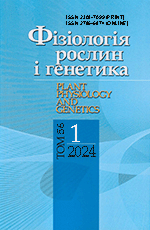Методами пророщування насіння в розчинах сахарози різних концентрацій, вимірювання водного потенціалу та індукції флуоресценції хлорофілу листків за польових умов проведено порівняльне дослідження впливу водного дефіциту на посухостійкість восьми сортів бавовнику. Показано, що за умов недостатнього водозабезпечення знижуються показники проростання насіння, водного потенціалу та параметрів індукції флуоресценції хлорофілу листків усіх досліджених сортів бавовнику, однак ступінь зміни досліджених показників у різних сортів відрізнявся. Відповідно до отриманих даних усі сорти було розподілено на три групи: посухостійкі, средньостійкі і нестійкі до посухи. Встановлено повну відповідність змін характеристик індукційних кривих флуоресценції хлорофілу листків і показників водного режиму рослин бавовнику, що вказує на перспективність використання методу індукції флуоресценції хлорофілу для діагностики посухостійкості генотипів бавовнику.
Ключові слова: Gossypium hirsutum L., cotton, drought tolerance, water potential, induction of chlorophyll fluorescence
Повний текст та додаткові матеріали
У вільному доступі: PDFЦитована література
1. Ahmedzhanov, I.G., Agishev, V.S., Dzholdasova, K.B. & Tashmuhamedov, B.A. (2013). The use of a portable fluorometer to study the effect of water deficiency on the characteristics of delayed fluorescence of cotton leaves. Doklad AN RUz., 3, pp. 58-60 [in Russian].
2. Veselovskiy, V.A. & Veselova, T.V. (1990). Luminescence plants. Theoretical and practical aspects. Moskva: Nauka [in Russian].
3. Doang, Hoang Zhang & Tohtar, V.K. (2011). Investigation of drought tolerance of promising species for introduction of Momordica charantia and Momordica balsamina (Cucurbitaceae). Nauchnyie vedomosti BGNIU., Estestv. nauki, Iss. 15, No. 9 (104), pp. 43-47 [in Russian].
4. Karymova, I.S. (2009). The effect of prolonged soil drought on the physiological processes in various varieties and cotton lines (Unpublished candidate thesis). Dushanbe [in Russian].
5. Korneev, D.Yu. (2002). Informational possibilities of the method of induction of chlorophyll fluorescence. Kiev: Altpres [in Russian].
6. Korneev, D.Yu., Nizhnik, T.P., Grigoryuk, I.A. & Kochubey, S.M. (2002). Fluorescence induction of potato leaf chlorophyll under water deficiency conditions. Fiziologiya i biohimiya kult. rasteniy, 34, No. 1, pp. 67-78 [in Russian].
7. Kushnyrenko, M.D., Goncharova, E.A. & Bondar, E.M. (1970). Methods for studying water metabolism and drought tolerance of fruit plants. Kishinev: Shtiintsa [in Russian].
8. Pikulenko, M.M. & Bulyichev, A.A. (2007). Using the parameters of fluorescence and the generation of electrical potentials in the membranes of plant cells to assess the state of biological objects. Byul. Mosk. o-va ispyit. prirody. Biologiya, 112 (1), pp. 80-84 [in Russian].
9. Tretyakov, N.N., Karnauhova, T.V. & Panichkin, L.A. (1990). Practical work of plant physiology. M.: Agropromyzdat [in Russian].
10. Rekomendatsii NITs MKVK po proektu IUVR-Fergana (Uzbekistan). The need of main crops for irrigation water in phases of development. Tashkent [in Russian].
11. Shadchina, T.M. & Pryadkina, G.A. (2006). The effect of soil salinization and nitrogen nutrition deficiency on the activity of the violaxanthine cycle and non-photochemical quenching of chlorophyll fluorescence in wheat leaves. Fiziologiya i biohimiya kult. rasteniy, 38, No. 3, pp. 214-221 [in Russian].
12. Ackerson, R.C., Krieg, D.R., Miller, T.D. & Zaetman, R.E. (1977). Water relations of field grown cotton and sorghum: Temporal and diurnal changes in leaf water, osmotic, and turgor potentials. Crop Sci., 17, pp. 76-80. https://doi.org/10.2135/cropsci1977.0011183X001700010022x
13. Lichtenthaler, H.K. (1992). The Kautsky effect: 60 years of chlorophyll fluorescence induction kinetics. Photosynthetica, 27, No. 1-2, pp. 45-55.
14. Loka, D.A., Oosterhuis, D.M. & Ritchie, G.L. (Eds.). (2011). Water deficit stress in cotton. Stress physiology in cotton. Referens book series . The cotton Foundation. Cordova, Tennessee, USA, No. 7, pp. 37-72.
15. Maxwell, K. & Johnson, G.N. (2000). Chlorophyll fluorescence - a practical guide. Journal of Experimental Botany, 51, No. 345, pp. 659-668. https://doi.org/10.1093/jexbot/51.345.659
16. Nyachiro, J.M., Briggs, K.G., Hoddinott, J. & Johnson-Flanagan, A.M. (2001). Chlorophyll content, chlorophyll fluorescence and water deficit in spring wheat. Cereal Research Communications, 29, No. 1-2, pp. 135-142.
17. Posudin, Yu. & Bogdasheva, O. (2010). Fluorescence analysis of green pea Pisum sativum during development and under external factors. Sci. Bull. of NAU, No. 5, pp. 21-28.
18. Posudin, Yu.I., Godlevska, O.O., Zaloilo, I.A. & Kozhem'yako, Ya.V. (2010). Application of portable fluorometer for estimation of plant tolerance to abiotic factors. Int. Agrophysics., 24, No. 4, pp. 363-368.
19. Ronacek, K. & Bartak, M. (1999). Technique of the modulated chlorophyll fluorescence: basic concepts, useful parameters, and some applications. Photosynthetica, 37, No. 3, pp. 339-363. https://doi.org/10.1023/A:1007172424619
20. Zlatev, Z.S. & Yordanov, I.T. (2004). Effects of soil drought on photosynthesis and chlorophyll fluorescence in bean plants. Bulg. J. Plant Physiol., 30, pp. 3-18.
